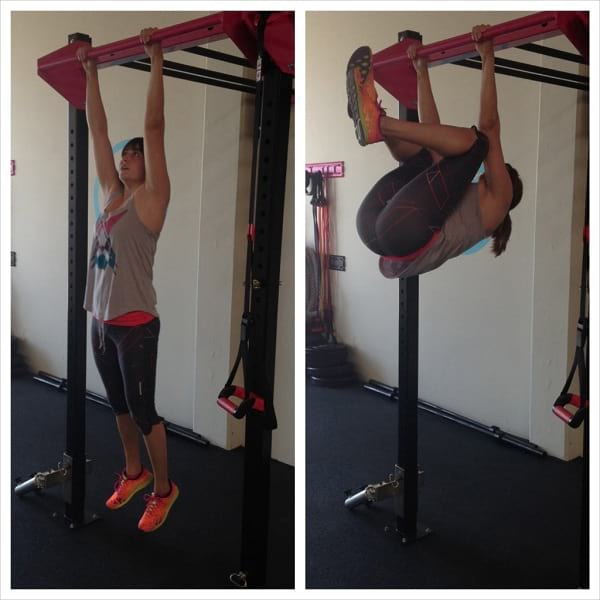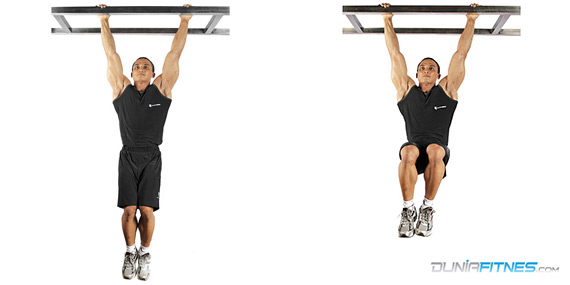Video Demonstration
The Hanging Knee Tuck will challenge your core and help you to sculpt out that strong and defined six pack that everyone wants to have.
There are two different variations of this exercise that will change the central focus between the Abdominals and your Hip Flexors.
The first variation we will focus on will primarily target your abdominals and move them through their full range of motion.
The second variation will primarily focus on your hip flexors and work your abdominals with an isometric contraction.
In this article, we will provide image and video demonstrations with a step by step description explaining how to perform the movement.
The difficulty level and equipment required to do this exercise. The different muscles that get worked. Some training tips to make sure you are doing the exercise correctly.
Hanging Knee Tuck How to Guide Abdominal Focus
Image Example

Step by Step Description
Step 1: Grap a pull-up bar with a shoulder width grip. You can use an overhand (palms facing away) or underhand (palms facing toward your body) grip. Pull your shoulders down and back
Step 2: Exhale, Pull your knees towards your chest while pulling your abdominals towards your spine. Round/Roll your lower back putting the pelvis into a posterior tilt. If someone was facing you, he or she should see your butt and no longer be able to see your face when your knees get fully raised. Doing this will ensure that the focus is on your abs and not the hip flexors.
Step 3: Inhale and lower your legs slowly back to the starting position. Keep your core flexed as you lower your legs and pause at the bottom position to prevent swinging.
You have now completed one repetition.
Hanging Knee Tuck How to Guide Hip Flexor Focus
Image Example

Step by Step Description
Step 1: Grap a pull-up bar with a shoulder width grip. You can use an overhand (palms facing away) or underhand (palms facing toward your body) grip. Pull your shoulders down and back
Step 2: Exhale, Pull your knees upwards until your thighs are parallel with the floor. Keep your back straight and initiate the movement from your hips. Now your abs will be used with an isometric hold.
Step 3: Inhale and lower your legs slowly back to the starting position. Keep your core flexed as you lower your legs and pause at the bottom position to prevent swinging.
You have now completed one repetition.
Difficulty Level
This exercise has an intermediate difficulty level.
This training method is suitable for people who have been conditioning their abdominals for at least a few months.
If you are new to exercising you should spend some time doing plank variations before moving to this lift.
Equipment Required
To perform this exercise, you will need a Pull-Up Bar.
If you do not currently have a pull-up bar, you can get one from Amazon for a good price.
Muscles Worked
The primary muscles used for this exercise are your Hip flexors and the Abdominals.
The secondary muscles that assist with this exercise are your Forearms, Shoulders and the upper back (Traps).
If you want to add additional oblique training all you need to do is raise your knees up and to the side.
Hanging Knee Tuck Benefits
You will get all the benefits of the traditional crunch with none of the back pain that commonly comes with them.
A strong core can help to reduce lower back pain by preventing excessive anterior tilt to the pelvis.
To have good posture, you need strong abs. When your abs are strong, it will help to prop up your spine. Good posture also reduces the wear and tear on your spine reducing the chance of disc herniation.
Training Tips
Do not swing your body back and forth. Keep your torso as still as you can. Swinging reduces the amount of work done by your abdominals.
To prevent your body from swinging pause for a second when you bring your knees back to the lowered position.
Jerking your legs up also reduces the force exerted on your abdominals. Focus on contracting your core muscles to perform the movement.
When you are hanging from the bar, your lower back should be in the neutral position. Do not allow the bottom part of your back to hyperextend.
If you shrug your shoulders, there will be additional force placed on the shoulder joint. Keep your shoulders in the down and back position, doing this will recruit your lats instead of the shoulder joint.
Use a slow and controlled movement on both the lifting and lowering of your knees.
For the Second variation of this exercise, when you thighs are parallel to the floor, hold this position for anywhere between 2 and 5 seconds.
If you cannot hold the bar long enough to fatigue your abs try using the underhand grip with your palms facing towards you to hold the bar. Your biceps are naturally strong, and you will be able to hold the bar longer than you can with an overhand grip.
Inclosing
Use this exercise to build strength and definition to your abdominals.
Having a strong core is important and will help to make other lifts and your everyday activities easier to do.
Looking to gain more strength or lose some weight? We offer free fitness tools to help you reach your fitness goals. Register for free while we are in beta and get free lifetime access to our fitness tools that include an easy to use Calorie Counter, High-Intensity Interval Timer, Multiple Fitness Calculators and our Exercise Logger.